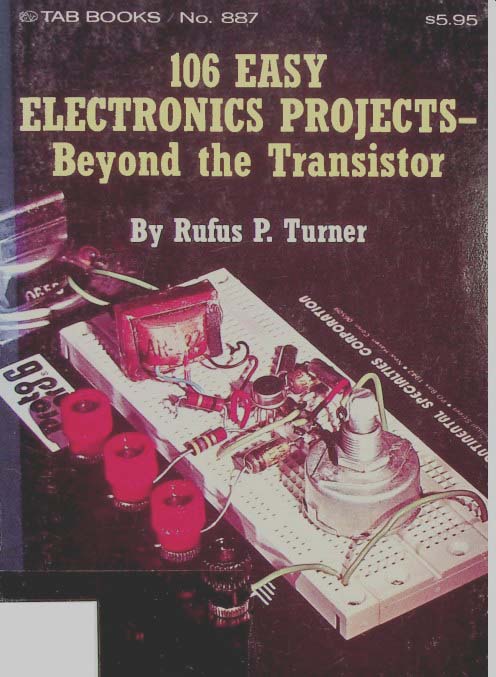CONTENTS
Field-Effect Transistor FET: FET Theory-Audio Preamplifier-Two-Stage AF Amplifier- Untuned Crystal Oscillator-Tuned Crystal Oscillator-Phase- Shift Audio Oscillator-Product Detector-All-Wave Regenerative Receiver-Superregenerative Receiver- Electronic DC Voltmeter-Direct-Reading Capacitance Meter-Initial Calibration
Metal Oxide Semiconductor Field-Effect Transistor MOSFET: MOSFET Theory-General Purpose RF Amplifier-Ten-Meter Preamplifier-Wideband Instrument Amplifier-Source Follower-Q Multiplier-Wide-Range LC Checker-Interval Timer-Capacitance Relay-Touch-Plate Relay- Electroscope-Ultrasonic Pickup
Integrated Circuit IC: IC Theory-Complete Audio Amplifier-Audio Power Amplifier With MOSFET Input-24-Watt Intercom-Very Low-Resistance DC Milliammeter-Electronic DC Millivoltmeter-Low-Pass Active Filter-High-Pass Active Filter-Combination High-Pass. Low-Pass Active Filter-Bandpass (Peak) Active Filter-Active Bandstop (Notch) Filter-Conventional Bandpass Active Filter-Signal Tracer-Group Code-Practice Oscillator
Unijunction Transistor UJT: UJT Theory-Pulse Generator-Pulse and Timing Generator-Free-Running Multivibrator-One-Shot Multivibrator- Relaxation Oscillator-Standard-Frequency Oscillator-CW Monitor-Metronome-Tone-Identified Signal System-Trigger for SCR
Tunnel Diode TD: TD Theory-General-Purpose AF-RF Oscillator- Crystal Oscillator-Voltage-Controlled RF Oscillator-Frequency Converter-Citizens' Band Converter-Audio Amplifier-Dip Meter-Regenerative Receiver-Flea-Powered CW Transmitter-Remote-Control Transmitter-Triggered Switch
Variable-Capacitance Diode VCD: VCD Theory-Voltage-Variable Capacitor-VCD-Tuned LC Circuits-Remotely Controlled Tuned Circuit-Voltage-Tuned RF Oscillator-Automatic Frequency Control for FM Receiver- Frequency Modulators-Frequency Multipliers-RF Harmonic Intensifier
Zener Diode: Zener Diode Theory-Simple DC Voltage Regulator-Simple. Higher Voltage DC Regulators-Multiple-Output DC Voltage Regulator-Light-Duty Regulated DC Supply-5-Volt. 1.25 Ampere Regulated DC Supply-18-Volt. 1-Ampere Regulated DC Supply-Voltage-Regulated Dual DC Supply-Regulated Voltage Divider-Transistor-Bias Regulator-Voltage Regulator for Tube Heater-Simple AC Voltage Regulator-Automatic Volume Limiter-DC-Equipment Protector-DC Voltage Standard
Diac: DiacTheory-Amplitude-Sensitive Switch-Static DC Switch- Electrically Latched Relay-Latching Sensor Circuit-DC Overload Circuit Breaker-AC Overload Circuit Breaker-Phase-Controlled Trigger Circuit
Triac: Triac Theory-Simple Triac Switch-General-Purpose Controller-Controller Using Combination Thyristor-DC-Controlled Solid-State AC Relay-Sensitive DC-Controlled Triac Switch- Motor Controls-Light Dimmers-Variable Dual DC Power Supply-Automatic Equipment Power Switch
Silicon Controlled Rectifier SCR: SCR Theory-Basic SCR Switches-Light-Controlled SCR-SCR Light Dimmer-SCR Motor Control-Photoelectric Burglar Alarm-Switch-Type Burglar Alarm-Photoelectric Garage- Door Opener-Variable DC Power Supply (115 Volts)-Variable DC Power Supply (High-Voltage)-DC-To-AC Inverter- Solid- State Timer
PREFACE:
This 1976-written guide is addressed to experimenters, technicians, students, and others who are already familiar with bipolar transistors and conventional diodes and who now want to work with other semiconductor devices. Fully tested circuits are given for FETs, MOSFETs, ICs, UJTs, tunnel diodes, varactors, zener diodes, diacs, triacs, and SCRs. No rectifiers, conventional diodes, or bipolar transistors appear except where they serve as auxiliary components in the main circuits.
The presentation is practical, save for an introduction, in each section, which describes in simple terms the device featured in that section. This format should enable the reader to learn the theory of the device quickly and should prepare him to use the circuits to better advantage.
In each section, the applications shown have been chosen because they seem best to exploit the advantages of the particular device. Electronic components are listed with each circuit diagram. But secondary parts-such as sockets, chassis, enclosures, miscellaneous hardware, and so on-are not specified, since the reader is free to choose these noncritical items according to his own preferences and demands.
author: RUFUS P. TURNER
While it is assumed that the reader is experienced in building, testing, and operating electronic equipment, he nonetheless should read carefully section 1, "Good Semiconductor Practice." if for no other reason than to reinforce his knowledge of the special precautions needed in handling semiconductor devices safely and successfully. The author and publisher hope that this guide will prove both instructive and entertaining.
This guide is adapted from this book:
Also see:
Using Scopes in Transistor Circuits (1968)
Practical TRANSISTOR Servicing (1967)